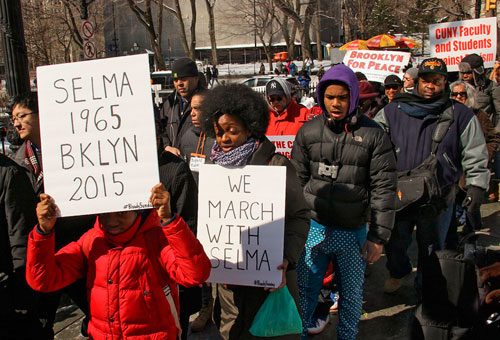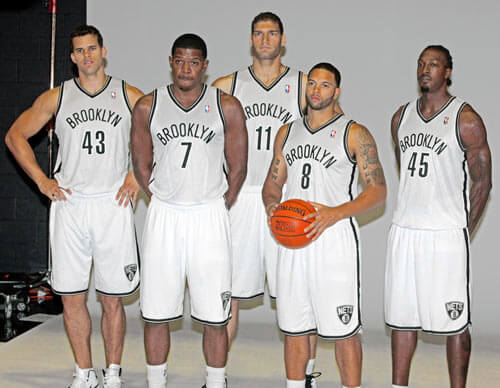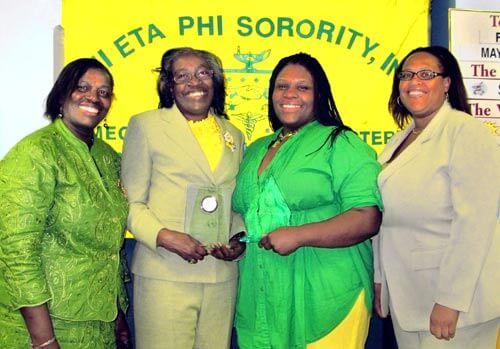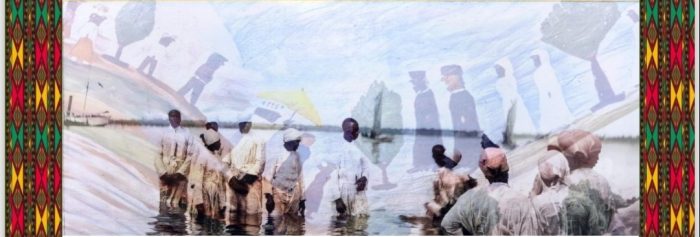Brooklyn Borough President Eric Adams, civil rights activist Norman Siegel, Karen Daughtry and State Senator Jesse Hamilton walked arm in arm over the Brooklyn Bridge on Saturday along with hundreds of others. Those who couldn’t make it to Selma, Alabama to mark the historic 50th anniversary of “Sunday Bloody Sunday” marched symbolically on Saturday.
“We’re fighting now for not just civil rights but human rights,” said Brooklyn Borough President Eric Adams at the rally at the Manhattan foot of the Brooklyn Bridge, prior to the march.
Mayor Dinkins, New York’s first Black mayor reminded the crowd what courage it took for the marchers to take that walk. “We think it’s important that people not forget Bloody Sunday. You’d be surprised how many young people don’t know.”
Fifty years ago on March 7, 1965, John Lewis, SNCC and SCLC activists and other supporters of Black voting rights — a total of 600 — peacefully walked two-by-two on the sidewalk of the Edmund Pettus Bridge over the Alabama River.
The march was a response to the shooting death of Jimmy Lee Jackson by a state trooper at an earlier protest for voter rights at the Dallas County Courthouse and a continuing commitment to the voter rights’ cause.
State troopers and police waited at the end of the bridge. Refusing to turn back, the marchers were subjected to tear gas and brutal beatings, all recorded by the media.
The violence televised around the world and the continued pressure on politicians led to the federal Voting Rights Act passed Aug. 6, 1965.
A brilliant sun shone on the marchers who walked four abreast on the bridge. Their signs read: “Selma is everywhere” and “We March With Selma.” Many local politicians and activists were among those of all ages walking. A bass and snare drum band provided youthful rhythms for the march.
On the Brooklyn side, marchers walked to Brooklyn Borough Hall, where they congenially waited for almost two hours to hear President Obama’s address projected over TV monitors.
John Lewis, who has been a congressman from Georgia since 1987, spoke before the president. He evoked the sacrifice of Jimmy Lee Johnson and how the people were inspired to do what they were called to do resulting in their vicious beatings.

The gathering of New Yorkers was clearly moved. “The country will never be the same from what happened on this bridge,” he said, recounting how eight days later President Johnson made the speech how this was a time when history and fate were meeting together. Five months later, the Voting Rights Act was passed.
President Obama began his speech. “It is a rare honor in this life to follow one of your heroes. And John Lewis is one of my heroes.”
“The air was thick with doubt, anticipation, and fear,” he said of the time just before the marchers began to walk.
The president took us through the civil rights heroes of those days and how we were celebrating them and the ordinary Americans who marched and led the nation and who were just seeking equal treatment.
The president’s oratory was so moving that audience members were brought to tears at times, to shouts and applause at other times.
As voting rights are at risk in some states, the president called on members of Congress to pledge to make it their mission to restore the law this year.
“We honor those who walked so we could run. We must run so our children soar,” President Obama said, wrapping up his almost 40-minute speech.
Brooklyn-resident Jamaican-born Dr. Elaine Duvall was among those who listened to the broadcast. “I’m here to participate in this historic event. It’s historically significant with the first Black president,” she said, acknowledging the racial issues absorbing the nation right now. She spoke of how important it was to reflect on the meaning of the Selma march, the sacrifices and prices paid and to honor and carry on the mission and dream.
The civil rights protest, the reactionary violence, pressure put on the federal government and President Johnson’s speech is the subject of the acclaimed film “Selma.”



























